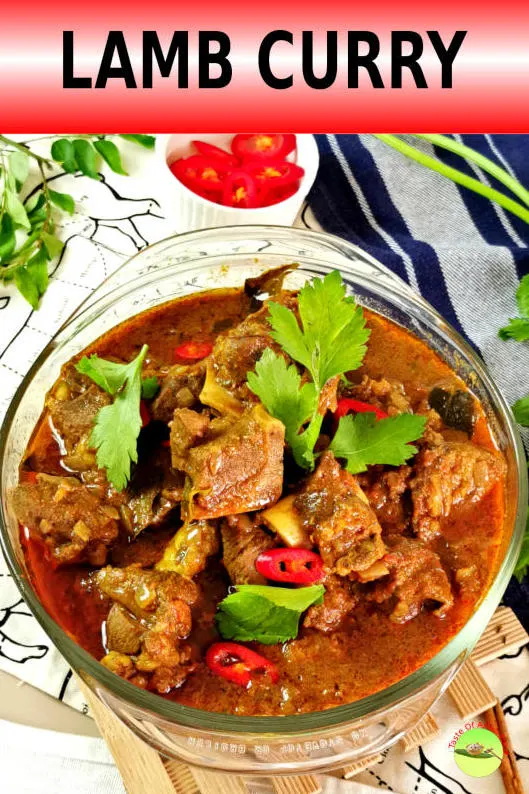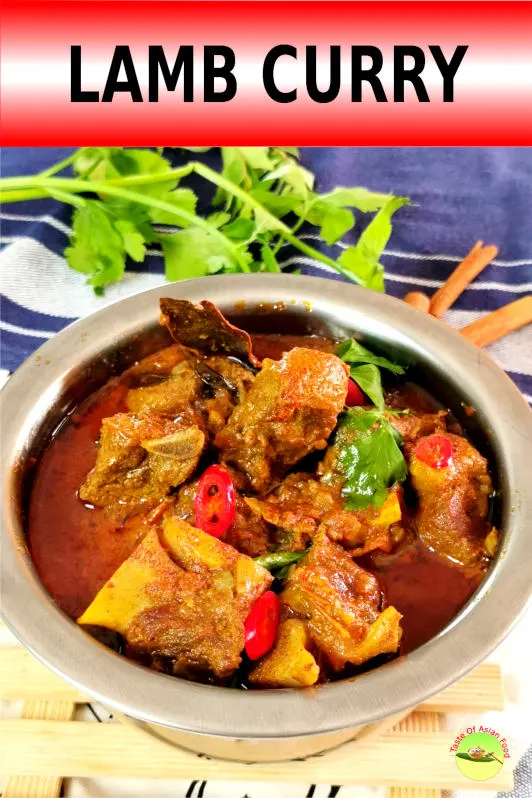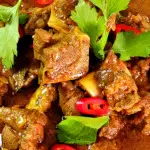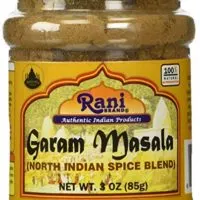I want to share our family lamb curry recipe, which my wife would die for. She tried to resist the temptation to keep the leftovers for the next meal before finally submitting to my suggestion to share with her sister.
This lip-smacking lamb curry recipe is a fusion curry that leans heavily on Indian origin and is perfumed with a unique blend of Malaysian curry powder. The flavors’ intermingling immediately brightens the curry once added to the lamb.
After slow stewing at a barely simmer for 90 minutes, the tender meat almost melts off the bone enrobed in the umami-rich gravy. This lamb curry will be a serious contender when adding Asian flavor to your dinner rotation.
Let’s dive in immediately by showing you how to prepare the Malaysian-style lamb curry.

Note: This post may contain affiliate links. Please read my privacy policy for more info. I may receive commissions for purchases made through links in this post. As an Amazon Associate, I earn from qualifying purchases.
The Malaysian-style lamb curry is very similar to the authentic Indian version except for including the Malaysian curry powder, a unique blend of the local spices. The gravy is thick, and the flavor is concentrated.
1. Marinate the lamb
I prefer to use bone-in lamb because it imparts flavor to the curry. Ask your butcher to cut it into 1.5-inch cubes or larger since the meat will shrink during cooking. You need to adjust the lamb quantity from 1kg to 600g should you decide to use boneless lamb shoulder and replace the water with chicken stock to intensify the flavor.
This lamb curry recipe is very flexible, converting easily to chicken or beef curry by replacing the lamb for those who do not eat lamb.
The marinade
Marinate is a crucial step to tenderize the lamb.
I add some yogurt to marinate the lamb for two reasons. First, it adds a delicious tangy flavor but, more importantly, tenderizes the lamb.
Yogurt tenderizes the meat in two actions. It contains friendly bacteria, which breaks down protein. It also contains lactic acid, which is mildly acidic and helps break down the meat by denaturing or unwinding the muscle’s long protein. Since yogurt is a weak acid and lamb is tougher than chicken, it will not be overly tenderized, even marinated overnight.
The marinate also comprises ginger, garlic chili powder, turmeric powder, and salt.
Massage the marinade into the lamb and let it rest for at least three hours or overnight.
You can crush the garlic and ginger with the flat of your cleaver and finely mince them if you do not have the ginger garlic paste ready.
2. Temper the herbs and spices
I temper the spices and sear the lamb separately to prevent the spices from overburning.
- Heat some cooking oil to just below the smoking point. Most Malaysians use peanut or palm oil to cook, but you can also use corn oil, coconut, or sunflower oil, which have a high smoking point.
- Add the dried spices (cardamom, bay leaves, curry leaves, cinnamon bark) to the oil to temper until it becomes aromatic.
- You may add cumin seeds to the recipe. I use the ground cumin and only add it to the curry at a later stage.
- There are other versions of the lamb curry, which include fennel seeds. They should be tempered with other dried herbs if you choose that option.
- When the whole spices become aromatic, add the chopped yellow onions and sauté for a few minutes until it become soft, slightly brown, and translucent.
- Remove it and use the same pan to brown the lamb.
3. Browning the lamb
Browning gives the lamb a richer, deeper, and more complex flavor through the Maillard reaction, which produces a range of flavored molecules responsible for the inviting flavor and color. Unfortunately, it does not happen while cooking the curry because it takes place at around 140°C to 165 °C (280°F to 330 °F). Therefore, browsing enhances the flavor of all stew dishes.
I prefer to brown the lamb separately to avoid the spices from overburning. A good nonstick pan is useful for browning with less oil if you do not object to using nonstick material.
After browning the meat, set it aside, remove the excess oil, and use the same pan for cooking the curry. Use some water or add the chopped tomatoes to deglaze the pan. These are treasures which greatly enhance the flavor of the curry.
4. Prepare the gravy of the curry
Add the chopped tomatoes to the pan to deglaze the pan over medium heat. Once the caramelized bits have loosened, add back the browned lamb.
The tomatoes will start to disintegrate and release more liquid. You must add some water as it is too dry to simmer the lamb. An alternative to fresh tomatoes is substituting with tomato sauce or tomato puree.
Meanwhile, add the remaining spice powder: chopped green chili, garam masala, chili powder, Malaysian curry powder, ground cumin, and ground coriander. Mix well and cover. Simmer over very low heat to keep it barely simmer.
5. Simmer the lamb until tender and soft
It will take at least 90 minutes before the lamb becomes soft and tender. Slow cooking is the key. You can either do it in a regular pot or a Dutch oven. You may need to add more water occasionally to avoid drying up. I prefer to add boiling water to keep the temperature constant. Since I want to keep my curry reasonably dry, I only add a minimum amount of water. The curry will cook down to a thick gravy with an intense flavor.
Note: Using a pressure cooker to prepare most curries can shorten the cooking time.
There is an option to have more gravy by adding more water and thickening it with potato wedges. The potatoes act like a sponge, absorbing all the gravy flavor, and are extremely tasty. Add the potatoes about half an hour before removing the curry from the stove.
It is necessary to do a taste test before serving, as the amount of water in the curry may differ. If it is too salty, you can still add some curry powder or water if you want a spicier flavor.
Adding coconut milk is an option to thicken and flavor the gravy.
Garnish the curry with some coriander leaves and red chili slices. Add a squeeze of lime or lemon juice before you serve. It is best to serve with basmati rice, homemade naan, or chapati.

Five tips to make the best Malaysian lamb curry
1 Use Malaysian curry powder.
This curry powder is the star of the lamb curry recipe. It is a spice blend of coriander seeds, dried chili, fennel seeds, turmeric, white pepper, cinnamon sticks, black pepper, cardamom, star anise, nutmeg, bay leaf, and clove. You can immediately spot a few common spices for Malaysian cuisine: ground fennel, dried chili, star anise, and nutmeg. I can attest it tastes pretty distinct from the Indian curry once you include it in this lamb curry recipe. The Malaysian curry powder is sold at Amazon and should be available at your nearby Asian grocery store.
Make your Malaysian curry powder
You can make this spicy blend at home easily with the recipe below if it is not sold in the store:
- 4 dried red chiles
- 4 cardamom pods
- 1 cinnamon stick (5cm length)
- 4 tbsp coriander seeds
- 2 tbsp cumin seeds
- 2 tsp fennel seeds
- 10 cloves
- 10 black peppercorns
- 1 tsp turmeric powder
All you need is to toast these spices over a frying pan until aromatic (except for the turmeric powder), then process with the spice grinder. Next, sieve the spice mix through a fine wire mesh strainer and keep it in an airtight container.
2. Use bone-in lamb
lamb curry is better cooked with bone-in shoulder and shanks since the bone and marrow impart flavor. You can substitute part of the water with chicken or beef stock to make up the flavor of bones if you are using boneless lamb.
3 Marinate the lamb with yogurt
Lamb is relatively tougher and should be marinated to make it soft and tender. The easiest way is to use a slightly acidic marinade; yogurt is my preferred choice. It helps to break down the protein, tenderizes the lamb, and imparts extra flavor.
Alternatively, a small amount of the store-bought tenderizer will do the trick. Most of these natural tenderizers contain pineapple (bromelain) or papaya (papase) enzymes.
3. Deglaze the pan
The caramelized bits that stick on the pan after browning are flavorful. However, there are times when it gets burned and has to be discarded,
You must balance not burning it while still hot enough to brown the meat. Using a nonstick pan is more manageable, although you must always pay attention to the stove’s heat.
4. Use generous amounts of spices
The flavor of the curry relies on the combination of the aromatic spices. The amount should be generous, resulting in an explosive flavor attacking the palates. Scoop a full teaspoon with confidence when the recipe asks for a teaspoon. I can hardly think of any incident where the curry is over-spiced.
5. Simmer low and slow on the stove
lamb is relatively tough compared to poultry, which takes longer to cook until tender. The trick is to cook it over a long period at a barely simmering temperature.
The difference between lamb and mutton
Lamb is the meat from young sheep below one year, and mutton is from the fully grown sheep.
However, the word mutton is used interchangeably in Southeast Asia because the locals often do not eat sheep. So when we ask for mutton in the butcher’s shop, it is likely given a piece of goat meat. Fortunately, this recipe suits lamb and mutton curry, and no adjustment is required.
Related recipes
There are a few popular recipes related to this slow-cooked lamb curry. Don’t let these lip-smacking recipes slip through your palate.
Easy chicken curry – The Malaysian-style chicken curry is prepared with Malaysian curry powder. It is a quick and easy recipe.
Massaman Curry – A Southern Thailand curry that is less spicy. It was voted as one of the world’s top ten most delicious foods by CNN Travel in 2011.
Chinese-style lamb cutlets – A homegrown recipe by the Malaysian Chinese. It is prepared mainly with Chinese seasoning but also with Worcestershire sauce, a unique hybridized flavor.

Lamb Curry
This lip-smacking lamb curry is just delicious layered upon delicious. It is a hybridized curry that leans heavily on Indian origin and is perfumed with a unique blend of Malaysian curry powder. The intermingling of flavors immediately brightens up the curry once it is added to the lamb.
Ingredients
Marinate (A)
- 1kg lamb (with bone, 1.5-inch cube chunks)
- 4 tbsp yogurt
- 1 tbsp ginger garlic paste
- 1 tsp salt
- 2 tsp turmeric powder
- 1 tsp chili powder
Other ingredients (B)
- 2 tbsp cooking oil
- 6 cardamom
- 4 bay leaves
- 2 stalk curry leaves
- 2 cinnamon barks, about 2 inches each
- 300g onion (two medium, chop or blend into a paste)
- 300g tomato (two medium, chop or blend into a paste)
Spices (C)
- 2 green chilies, chopped
- 1 tbsp garam masala
- 2 tsp ground cumin
- 1 tbsp ground coriander
- 1 tbsp Malaysian curry powder
- 1 tsp salt
- 1 tsp chili powder
- 1/2 cup of water
Garnish (D)
- Coriander leaves and cuts red chili to garnish
Instructions
- Marinate the lamb with (A) overnight or at least half of the day.
- Heat some oil to just below the smoking point. Add the dried spices (cardamom, bay leaves, curry leaves, cinnamon bark) to the oil to temper until it becomes aromatic.
- Add the chopped onion and sauté for a few minutes until it becomes soft, slightly brown, and translucent. Set aside.
- Using the same pan, brown the lamb with some oil. Be careful not to burn the caramelized bit sticking to the pan.
- Remove the lamb. Add the chopped tomatoes to deglaze the pan. Once the caramelized bits have loosened, add back the browned lamb.
- Add the remaining items in (C). Simmer over very low heat for 90 minutes.
- Garnish with some coriander leaves and red chili slices.
Recommended Products
As an Amazon Associate and member of other affiliate programs, I earn from qualifying purchases.
-
 Rani Garam Masala Indian 11 Spice Blend 3oz (85g) Salt Free ~ All Natural | Vegan | Gluten Free Ingredients | NON-GMO
Rani Garam Masala Indian 11 Spice Blend 3oz (85g) Salt Free ~ All Natural | Vegan | Gluten Free Ingredients | NON-GMO -
 GreenLife CW002044-002 Healthy Nonstick Dishwasher Oven Safe Sta Soft Grip Diamond Reinforced 8" Ceramic Non-Stick Open Frypan, 8-Inch, Black
GreenLife CW002044-002 Healthy Nonstick Dishwasher Oven Safe Sta Soft Grip Diamond Reinforced 8" Ceramic Non-Stick Open Frypan, 8-Inch, Black -
 Asian Kitchen Ginger-Garlic Cooking Paste 26.5oz (750g) ~ Vegan | Glass Jar | Gluten Free | NON-GMO | No Colors | Indian Origin
Asian Kitchen Ginger-Garlic Cooking Paste 26.5oz (750g) ~ Vegan | Glass Jar | Gluten Free | NON-GMO | No Colors | Indian Origin -
 NT# NT# Baba's Packet Curry Powder - Meat 125g -This powder is use for rich curry taste or marinades for chicken and meats
NT# NT# Baba's Packet Curry Powder - Meat 125g -This powder is use for rich curry taste or marinades for chicken and meats
Nutrition Information:
Yield: 4 Serving Size: 1Amount Per Serving: Calories: 1059Total Fat: 71gSaturated Fat: 26gTrans Fat: 0gUnsaturated Fat: 38gCholesterol: 269mgSodium: 1964mgCarbohydrates: 30gFiber: 7gSugar: 9gProtein: 75g
This data was provided and calculated by Nutritionix on 11/25/2020

Lynn
Thursday 14th of September 2023
In your video you do not add the chilli powder? But in your recipe it’s there at the bottom?
Lynn
Saturday 25th of November 2023
@KP Kwan, Hi,
Will do, to be honest I’ve made this curry a few times now, always adding the chilli powder, me and my partner absolutely love it. So glad I found it. Thank you
KP Kwan
Friday 15th of September 2023
Sorry for that. The video might have accidentally cut off the scene. Please follow the written recipe. Thanks.
philip
Saturday 22nd of October 2022
May I respectfully suggest that Hoggett or Mutton would make an ideal substitute, but subject to a longer, lower temperature, cooking time?
KP Kwan
Monday 24th of October 2022
Thanks for your suggestion.
Phil
Sunday 3rd of July 2022
Is it possible to make this recipe in a slow cooker ?
KP Kwan
Monday 4th of July 2022
I do not see any problem so please go ahead.
Lynn
Monday 6th of June 2022
Are you supposed to put chilli powder in the marinade, as it says it in most of the description and the ingredient part but not in your video? I mean it’s too late now as it’s been marinading already, but for future reference.
KP Kwan
Tuesday 7th of June 2022
Hi Lynn, Curry powder is essential for this recipe. However, there is no need to add curry powder as part of the marinade. Instead, please add the curry powder and other species in Ingredients C to cook/simmer the meat. KP Kwan
Jim Knox
Wednesday 21st of April 2021
Nice recipe of lamb curry, will try today.